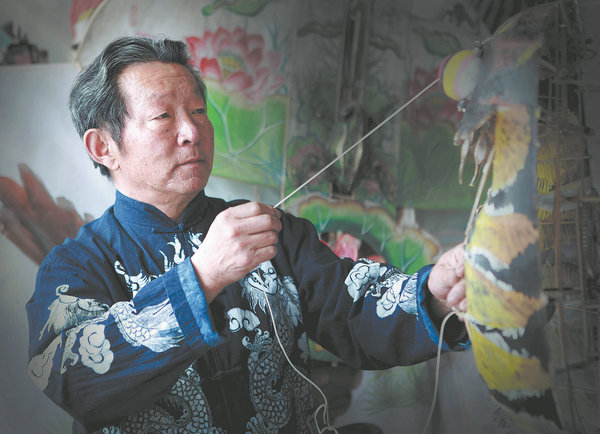NEWS
By Wang Kaihao | China Daily | Updated: 2025-06-17 09:22

National-level inheritor of traditional kite-making techniques, Zhang Xiaodong, at work in Weifang, Shandong province. [Photo provided to China Daily]
A decade-long nationwide project for systematic recordings and rescue of intangible cultural heritage, or ICH, has borne fruit, as the Ministry of Culture and Tourism released its findings on Friday, the eve of the country's 20th annual Cultural and Natural Heritage Day.
Coorganized by the ICH department of the ministry and the National Library of China, the project was launched in 2015, covering a wide range of categories from folk literature, music, dancing and operas to traditional craftsmanship, medicine and festival celebrations.
It expanded to detailed recordings of 2,290 national-level ICH inheritors, including oral history documentations, video recordings of their practice of ICH items and teachings, and category-related files, thanks to fiscal support from the central government. Among them, 1,279 recordings were completed.
An exhibition displaying the past decade's recording work opened in the national library on Friday and will run till October.
"Intangible cultural heritage items are witnesses to how the lineage of Chinese civilization has been passed down," said Chen Ying, deputy director of the National Library of China, at the opening ceremony of the exhibition.

Gao Xu (left), who is in charge of the recording project of national ICH inheritors from Liaoning province, during an interview. [Photo provided to China Daily]
"It's essential to establish a database for their inheritors to better preserve these living legacies," she said.
A main challenge faced by ICH is the aging of inheritors, so recording inheritors who are over 70 is a priority.
"I need to take responsibility for passing my skills down to next generations without any reservation," said Zhang Xiaodong, 76, a national-level inheritor of traditional kite-making techniques from Weifang, Shandong province.
Starting when he was 8, the man has dedicated his lifetime to this signature craftsmanship of Weifang. He has had over 200 disciples, and more than 7,000 people have attended his training sessions.
"The recording is a key way to benefit even more people and bring prosperity to this tradition," Zhang said.
The national recording project has involved over 4,000 staff from over 300 ICH research centers and libraries across the country. Altogether, they have collected over 75,000-hour-long video clips and 148 million Chinese characters in written documentations of oral history. More than 9,000 people were interviewed for this project. A 30-minute documentary will be made for every ICH inheritor.
"This job is a race against time," said Gao Xu, who is in charge of the recording work from Liaoning province. "Inheritors' health and age are the biggest enemies of those ICH items."
Before Gao finished her interviews on a practitioner of traditional sacrificial rituals of the Xibe ethnic group, the elderly man accidentally fell and was hospitalized.
"While taking care of the man, his family and neighbors from the village came to help us finish the recording," Gao recalled. "They also contributed scattered historical files or related old artifacts. They know our work is meaningful.
"The recordings are not only of individuals, but also how traditions were nurtured on that land," Gao said. "We see more than 'single trees' in the project. We see forests."
When Gao first approached Shan Tianfang, an iconic storyteller and oral performing artist, her request was turned down. Once a shining star on stage, Shan was worried that his appearance, suffering from illness, would disappoint fans.
"But he finally accepted the proposal, recognizing the significance of this national project, and we recorded for three days," Gao said. "He chose a new suit for the recording session."
Shan passed away one year after the recording was completed.
In the past decade, 71 national-level ICH inheritors passed away before recording programs were completed, and another 397 died afterward.
"Their lifetime devotion lives on thanks to the project," Gao said. "It will give new generations strength."